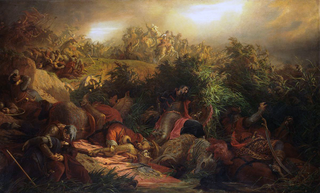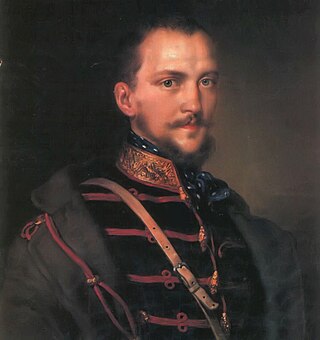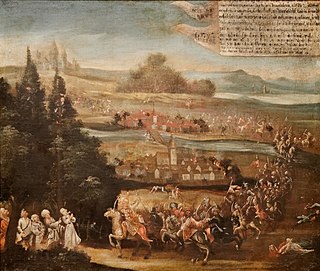For more information on the Árpád dynasty, see Árpád dynasty.
The military history of Hungary includes battles fought in the Carpathian Basin and the military history of the Hungarian people regardless of geography.
| History of Hungary |
|---|
 |
The military history of Hungary includes battles fought in the Carpathian Basin and the military history of the Hungarian people regardless of geography.
The first well established reference to Hungarians derives from Georgius Monachus' work in the 9th century. It mentions that around 837 the Bulgarian Empire desired an alliance with the Hungarians. [1] Although the Hungarians supposedly participated earlier at the Battle of Pliska in 811. [2] The Hungarians began the conquest of the Carpathian Basin in 895. They continued to raid adjacent countries for many years. The Hungarians were able to defeat three major Frankish imperial armies between 907 and 910, [3] however a military defeat in 955 forced them to withdraw and consolidate their gains.
The Magyars advanced as far as the Iberian Peninsula, the Coast of Normandy and city of Constantinople. [4]
The Magyar arts of war involved agility, speed, and precision. Their armies were well-organized and the men were well trained and disciplined. [5] The Hungarians used many tools of war to defeat their foes, the most characteristic of their weapons being the quick-firing reflex bow, which they fired accurately from the saddle, even at full gallop. They also carried sabers and spontoons, but the reflex bow remained their armament of choice. The Magyars placed an emphasis on ranged fighting – their charges were usually preceded by a volley of arrows, and followed up by hand-to-hand combat. The majority of their troops were trained to fight on horseback.
The Hungarians demonstrated a use of siege weapons, including a battering ram at the Siege of Ausburg. After the death of the last king Demetrius Zvonimir of Croatia, he left no heir, so his wife Helen, the sister of Saint Ladislaus I of Hungary called the Hungarian troops to take control of the kingdom. After Saint Ladislaus' death, his nephew, the King Coloman of Hungary ascended to the Hungarian throne. The feudal lords of Croatia elected a new king, and tried to get rid of the Hungarian occupation, and then the Hungarians took up arms against Croatia, and won a bloody victory at Gvozd Mountain. After this, Coloman was crowned as king of Croatia in 1102. The Hungarian chivalric army was at its best during the reign of Louis I, who also led campaigns against Italy in 1347 and 1350. Nevertheless, there were still light cavalry units in the army, consisting of, among others, Szeklers and the settling Kuns. On the winter of 1458 the 15 years old Mathias Corvinus was elected as king by the Hungarian nobility. During his reign he dealt with the noble factions, and created a centralized royal authority, supported mainly by the first permanent Hungarian mercenary army, the Fekete Sereg (King’s Black Army). Mathias favored the obsolete catapults over the modern cannons already employed by his father. Light cavalry, formed by hussars and Jász mounted archers, regained part of their former role in the Fekete Sereg.
On 2 September 1686 united Hungarian, Austrian and West-European troops liberated Buda from the Turkish occupation. By the end of the 17th century Christian armies led by Habsburgs conquered all the Turkish-ruled territories. Thereafter the Kingdom of Hungary was part of the Habsburg Monarchy.
A decisive part of the fighting force – about four fifth, most of the time – was formed by the main arm of the time: infantry. The other arm, cavalry, still consisted mainly of heavy cavalry, or units equipped with mail armor, called battle cavalry. Another two types of cavalry were dragoons and light cavalry. Hungarian hussars became internationally recognized, being a prime example of light cavalry. In this era artillery became a third arm.
Two significant attempts were made at achieving independence: the war for independence led by Francis II Rákóczi (1703–1711), and the Hungarian Revolution of 1848.

The Battle of Mohács was fought on 29 August 1526 near Mohács, Kingdom of Hungary, between the forces of the Kingdom of Hungary and its allies, led by Louis II, and those of the Ottoman Empire, led by Suleiman the Magnificent. The Ottoman victory led to the partition of Hungary for several centuries between the Ottoman Empire, the Habsburg monarchy, and the Principality of Transylvania. Further, the death of Louis II as he fled the battle marked the end of the Jagiellonian dynasty in Hungary and Bohemia, whose dynastic claims passed to the House of Habsburg.

Artúr Görgei de Görgő et Toporc was a Hungarian military leader renowned for being one of the greatest generals of the Hungarian Revolutionary Army.

The Kingdom of Hungary was a monarchy in Central Europe that existed for nearly a millennium, from 1000 to 1946. The Principality of Hungary emerged as a Christian kingdom upon the coronation of the first king Stephen I at Esztergom around the year 1000; his family led the monarchy for 300 years. By the 12th century, the kingdom became a European power.

György (Móric) Klapka was a Hungarian general. He was one of the most important Hungarian generals of the Hungarian War of Independence of 1848–1849, politician, member of the Hungarian Parliament, and deputy War Minister.
The military history of Croatia encompasses wars, battles and all military actions fought on the territory of modern Croatia and the military history of the Croat people regardless of political geography.

The Long Turkish War, Long War, or Thirteen Years' War was an indecisive land war between the Habsburg monarchy and the Ottoman Empire, primarily over the principalities of Wallachia, Transylvania, and Moldavia. It was waged from 1593 to 1606, but in Europe, it is sometimes called the Fifteen Years' War, reckoning from the 1591–1592 Turkish campaign that captured Bihać. In Turkey, it is called the Ottoman–Austrian War of 1593–1606.

The Hungarian Revolution of 1848, also known in Hungary as Hungarian Revolution and War of Independence of 1848–1849 was one of many European Revolutions of 1848 and was closely linked to other revolutions of 1848 in the Habsburg areas. Although the revolution failed, it is one of the most significant events in Hungary's modern history, forming the cornerstone of modern Hungarian national identity—the anniversary of the Revolution's outbreak, 15 March, is one of Hungary's three national holidays.

The Habsburg monarchy and the Ottoman Empire waged a series of wars on the territory of the Kingdom of Hungary and several adjacent lands in Southeastern Europe from 1526 to 1568. The Habsburgs and the Ottomans engaged in a series of military campaigns against one another in Hungary between 1526 and 1568. While overall the Ottomans had the upper hand, the war failed to produce any decisive result. The Ottoman army remained very powerful in the open field but it often lost a significant amount of time besieging the many fortresses of the Hungarian frontier and its communication lines were now dangerously overstretched. At the end of the conflict, Hungary had been split into several different zones of control, between the Ottomans, Habsburgs, and Transylvania, an Ottoman vassal state. The simultaneous war of succession between Habsburg-controlled western "Royal Hungary" and the Zápolya-ruled pro-Ottoman "Eastern Hungarian Kingdom" is known as the Little War in Hungary.

The siege of Buda ended with the capture of the city of Buda, the historical capital of the Kingdom of Hungary, by the Ottoman Empire, leading to about 150 years of Ottoman rule in parts of Hungary. The siege, part of the Little War in Hungary, was one of the most important Ottoman victories over the Habsburg monarchy during Ottoman–Habsburg wars in Hungary and the Balkans.

Johann Bernhard Stephan, Graf Pálffy de Erdőd was a Hungarian noble, Imperial Field marshal and Palatine of Hungary.

During the siege of Naģykanizsa in 1601, a small Ottoman force held the fortress of Naģykanizsa in western Hungary against a much larger coalition army of the Habsburg monarchy, while inflicting heavy losses on its besiegers.

The Spring Campaign, named also the Glorious Spring Campaign is the military campaign of the Hungarian Revolutionary Army against the forces of the Habsburg Empire in Middle and Western Hungary during the Hungarian Revolution of 1848 between 2 April and 21 May 1849, which resulted in the liberation of almost the whole territory of Hungary from the Habsburg forces.

The Battle of Tápióbicske was a battle in the Spring Campaign of the Hungarian War of Independence (1848–1849), fought on 4 April 1849 between the Austrian Empire and the Hungarian Revolutionary Army. The Habsburg forces consisted of the I Corps of the Imperial Army led by Lieutenant Field Marshal Josip Jelačić. The Hungarians deployed I and III Corps led by General György Klapka and General János Damjanich respectively. Although initially the careless soldiers of the I. corps were put to flight by the Croatian and Austrian soldiers, after entering in their trap, the Hungarians were victorious, thanks to the intervention of the III. corps, and the main Hungarian armies could advance towards the Hungarian capitals, forcing the Austrian high commander, Field Marshal Alfred I, Prince of Windisch-Grätz fight a decisive battle at Isaszeg, which would decide the fate of Central and Western Hungary until the intervention of the Russian forces on the Habsburg side in June 1849.

The Battle of Nagysalló, fought on 19 April 1849, was one of the battles between the Habsburg Empire and the Hungarian Revolutionary Army during the Spring Campaign in the Hungarian War of Independence from 1848–1849, fought between the Habsburg Empire and the Hungarian Revolutionary Army. Until 1918 Nagysalló was part of the Kingdom of Hungary; nowadays it is a village in Slovakia, its Slovakian name being Tekovské Lužany. This was the second battle in the second phase of the campaign, whose aim was to break the imperial siege of the fortress of Komárom and at the same time encircle the Habsburg imperial forces headquartered in the Hungarian capitals of Buda and Pest. The Hungarians routed the imperial corps led by Lieutenant General Ludwig von Wohlgemuth, which had come from the Habsburg Hereditary Lands, to help the imperial army sent to suppress the Hungarian Revolution of 1848 and independence.

The First battle of Komárom was one of the most important battles of the Hungarian War of Independence, fought on 26 April 1849, between the Hungarian and the Austrian Imperial main armies, which some consider ended as a Hungarian victory, while others say that actually it was undecided. This battle was part of the Hungarian Spring Campaign. After the revolutionary army attacked and broke the Austrian siege of the fortress, the Imperials, having received reinforcements which made them numerically very superior to their enemies, successfully counterattacked, but after stabilising their situation, they retreated towards Győr, leaving the trenches and much of their siege artillery in Hungarian hands. By this battle the Hungarian revolutionary army relieved the fortress of Komárom from a very long imperial siege, and forced the enemy to retreat to the westernmost margin of the Kingdom of Hungary. After this battle, following a long debate among the Hungarian military and political leaders about whether to continue their advance towards Vienna, the Habsburg capital, or towards the Hungarian capital, Buda, whose fortress was still held by the Austrians, the second option was chosen.

The siege of Buda took place at Buda castle, part of the twin capital cities of the Kingdom of Hungary. The Hungarian revolutionary army was led by General Artúr Görgei during the Hungarian War of Independence. Part of the Spring Campaign, the siege began on 4 May 1849, ending with the Hungarian capture of the castle by assault on 21 May.

The siege of Varaždin was a siege in the Kingdom of Croatia. The war came as a result of Croatian, Slavonian and Hungarian noble diets electing different candidates for their kings, following the death of Louis II of Hungary at Battle of Mohacs.
The Battle of Hetény, fought on 5 September 1849, between Hungarian Hussars led by General György Klapka and a Russian detachment of Cossacks was one of the last battles of the Hungarian War of Independence. After the surrender of the Hungarian army led by General Artúr Görgei at Szőlős, one of the last strongholds of the Hungarian independence was the fortress of Komárom, which now was being surrounded by Austrian and Russian troops. The small reconnaissance unit of Hungarian hussars which tried to acquire knowledge about the enemy's strength, was attacked by a platoon of Russian cossacks, but the Hungarians defeated them, using the tactic of feigned retreat. This kind of small scaled battles and skirmishes between Hungarian troops with the Austrian and Russian besieging units continued until the surrender of the fortress of Komárom on 2 October 1849.

The Ottoman–Habsburg war of 1540–1547 was a conflict between the Ottoman Empire and the Habsburg monarchy supported by their vassals. The war ended in Ottoman victory in 1547 after signing the peace of Edirne.
The Battle of Bicske happened on June 26, 1578, between the Ottoman army and the Habsburgs near Bicske. The Ottomans were victorious.
{{cite book}}: CS1 maint: location missing publisher (link){{cite book}}: CS1 maint: location missing publisher (link)